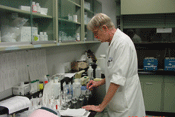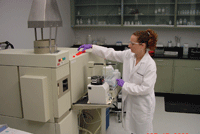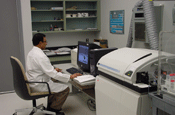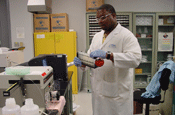EPA Region 6 Laboratory Inorganic Analysis Group
- About the Inorganic Analysis Group
- Inorganic Sample Preparation Laboratory
- Mercury Analysis
- Inductively Coupled Plasma Laboratory (ICP)
- Inductively Couple Plasma-Mass Spectrometry (ICP/MS)
About The Inorganic Analysis Group
The Inorganic Laboratory Group analyzes environmental samples for trace metals, mercury, and RCRA characteristics. The samples analyzed may include drinking water, waste treatment water, solid wastes, surface and ambient waters, and sediment/soils. These tests support all program areas including, air, water, RCRA, Superfund, and criminal investigation.
The Inorganic Analysis Group is part of the Laboratory Analysis Section under the direction of the Laboratory Analysis Section Chief.
Inorganic Sample Preparation Laboratory
The sample preparation laboratory is designed to prepare water and solid samples for analysis by Inductively Coupled Plasma (ICP), Inductively Coupled Plasma/Mass Spectrometry (ICP/MS), mercury, cyanide, and RCRA characteristics. The samples are subjected to a variety of digestion techniques. ICP and ICP/MS samples for water are routinely prepared by adding nitric and hydrochloric acids or nitric acid and hydrogen peroxide to a 50 ml aliquot then heating the sample on a hot plate until a reduction in volume allows acids to become concentrated. The heat and acids allow the metals within the samples to change to a state which can be detected by the instrumentation and quantified. A similar procedure is accomplished when soil or sludge samples are prepared using one gram of sample material. These procedures are simple and require only beakers, watch glasses, hot plates, and fume hoods. Final steps before analysis require filtration of the samples to remove any solid particles from the solution before analysis and volumetric flasks to bring the samples to a final volume of 100 ml.
Digestion of samples to be analyzed for mercury uses reagents such as sulfuric acid, concentrated nitric acid, potassium permanganate, and potassium persulfate which are added to a 100 ml water sample which is then incubated in a hot water bath at 95 degree Celsius for 2 hours. Soil samples use 0.2 grams of sample material and aqua regia in addition to potassium permanganate and incubation for 30 minutes in a hot water bath. Hydroxylamine reagent is added to all samples prior to giving the samples to the analyst. Other preparation techniques used on a non-routine basis may include microwave digestion, chelation pre-concentration, or direct analysis.
The Houston Laboratory has two mercury analyzers, both use cold vapor atomic absorption technology. The instruments are designed to measure the mercury vapor produced form the prepared samples upon the addition of stannous chloride reagent by the analyst. These instruments are similarly calibrated with known standard materials to establish a concentration curve. Sample concentration is calculated against this curve. The two systems differ in their detection limit capabilities. One instrument has a detection limit around 200 ug/liter and the other can detect 25-30 ug/liter mercury.
Inductively Coupled Plasma Laboratory (ICP)
The ICP laboratory contains one ICP-atomic emission spectrometer. The multichannelled instrument simultaneously measure up to twenty six (26) trace metals at once. The instrument introduces the digested sample into a spray chamber and into the very high temperature argon plasma. The emissions generated from the metals contained in the sample are optically focused onto photomultiplier tubes and intensities measured. The instrument is calibrated using mixed element standards. The emissions from standards and samples are ratioed to arrive at a sample concentration. The ICP will measure in the range of mg/liter to low ug/liter concentrations.
Inductively Couple Plasma-Mass Spectrometry (ICP/MS)
The ICP/MS instrument measures most of the elements in the periodic table which have naturally occurring isotopes. ICP/MS offers the opportunity to achieve lower detection limits at the part per trillion (ppt) range. The digested samples in the liquid form are introduced into the instrument sample introduction system which consists of a nebulizer and spray chamber. The nebulizer converts the liquid sample into very small droplets. These small droplets are carried through the spray chamber into the injector and then into the plasma which is at a temperature of approximately 6000C. The plasma ionizes the elements present in the droplets. These ions then pass through the interface and the ion lens. After being focused by the ion lens, the ions are separated by their mass-to-charge ratio in the mass spectrometer and measured by the detector. Once the detector measures the ions, the computerized data system is used to convert the measured signal intensities into concentrations of each element and generate a report of the results.

